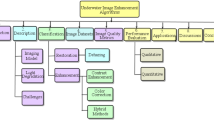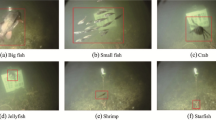Abstract
This paper proposes a new method for ship recognition and classification using sound produced and radiated underwater. To do so, a three-step procedure is proposed. First, the preprocessing operations are utilized to reduce noise effects and provide signal for feature extraction. Second, a binary image, made from frequency spectrum of signal segmentation, is formed to extract effective features. Third, a neural classifier is designed to classify the signals. Two approaches, the proposed method and the fractal-based method are compared and tested on real data. The comparative results indicated better recognition ability and more robust performance of the proposed method than the fractal-based method. Therefore, the proposed method could improve the recognition accuracy of underwater acoustic targets.
Similar content being viewed by others
References
Bao F, Li C, Wang X, Wang Q, Du S (2010). Ship classification using nonlinear features of radiated sound: An approach based on empirical mode decomposition. The Journal of the Acoustical Society of America, 128(1), 206–214. DOI: 10.1121/1.3436543
Becchetti C, Ricotti LP (1999). Speech recognition. John Wiley, New York, 1–67.
Chen C, Lee J, Lin M (2000). Classification of under-water signals using neural network. Tamkang Journal of Science and Engineering, 3(1), 31–48.
Diamant R, Lampe L (2013). Underwater localization with time synchronization and propagation speed uncertainties. IEEE Transactions on Mobile Computing, 12(7), 1257–1269. DOI: 10.1109/TMC.2012.100
Duda RO, Hart PE, Stork DG (2000). Pattern classification. John Wiley, New York, 282–320.
Eickstedt D, Schmidt H (2003). A low-frequency sonar for sensor adaptive, multistatic, detection and classification of underwater targets with AUVs. Proceedings of the OCEANS, San Diego, CA, USA. 1440–1447. DOI: 10.1109/OCEANS.2003.178074
Farrokhrooz M, Karimi M (2005). Ship noise classification using probabilistic neural network and AR model coefficients. Proceedings of the OCEANS, Washington, DC, USA, 1107–1110. DOI: 10.1109/OCEANSE.2005.1513213
Farrokhrooz M, Karimi M (2011). Marine vessels acoustic radiated noise classification in passive sonar using probabilistic neural network and spectral features. Intelligent Automation and Soft Computing, 17(3), 369–383. DOI: 10.1080/10798587.2011.10643155
He Xiying, Cheng Jinfang, He Guangjin (2010). Application of BP neural network and higher order spectrum for ship-radiated noise classification. Proceedings of the 2nd International Conference on Future Computer and Communication, Wuhan, China, 712–716. DOI: 10.1109/ICFCC.2010.5497336
Howell B, Wood S (2003). Passive sonar recognition and analysis using hybrid neural networks. Proceedings of the OCEANS, San Diego, USA, 1917–1924. DOI: 10.1109/OCEANS.2003.178182
Lennartsson R, Dalberg E, Levonen M, Lindgren D, Persson L (2006). Fused classification of surface ships based on hydroacoustic and electromagnetic signatures. Proceedings of the OCEANS, Singapore, 1–5. DOI: 10.1109/OCEANSAP.2006.4393910
Li Q, Wang J, Wei W (1995). An application of expert system in recognition of radiated noise of underwater target. Proceedings of the OCEANS, San Diego, CA, USA, 404–408. DOI: 10.1109/OCEANS.1995.526801
Lourens J (1988). Classification of ships using underwater radiated noise. Proceedings of the Conference on Communications and Signal Processing, Pretoria, South Africa, 130–134. DOI: 10.1109/COMSIG.1988.49315
Luo H, Wu K, Guo Z, Gu L, Ni L (2012). Ship detection with wireless sensor networks. IEEE Transactions on Parallel and Distributed Systems, 23(7), 1336–1343. DOI: 10.1109/TPDS.2011.274
Oppenheim A, Schafer R (1989). Discrete-time signal processing. Prentice-Hall, Upper Saddle River, USA, 541–628.
Orfanidis S (1996). Optimum signal processing: An introduction. McGraw-Hill, New York, 234–290.
Rajagopal R, Sankaranarayanan B, Ramakrishna RP (1990). Target classification in a passive sonar—an expert system approach. Proceedings of the Acoustics, Speech, and Signal Processing, Albuquerque, USA, 2911–2914. DOI: 10.1109/ICASSP.1990.116235
Rogoyski A, Dawe F, Robinson M (1994). Passive sonar data processing. Proceedings of the 6th Undersea Defense Technology Conference, London, UK, 310–313.
Sadjadi F, Chun C (2001). Passive polarimetric IR target classification. IEEE Transactions on Aerospace and Electronic Systems, 37(2), 740–751. DOI: 10.1109/7.937487
Shi GZ, Hu JC (2007). Ship noise demodulation line spectrum fusion feature extraction based on the wavelet packet. Proceedings of the International Conference on Wavelet Analysis and Pattern Recognition, Beijing, China, 846–850. DOI: 10.1109/ICWAPR.2007.4420787
Soares-Filho W, De Seixas J, Pereira Caloba L (2000). Averaging spectra to improve the classification of the noise radiated by ships using neural networks. Proceedings of the Sixth Brazilian Symposium Neural Networks, Rio de Janeiro, Brazil, 156–161. DOI: 10.1109/SBRN.2000.889731
Soares-Filho W, De Seixas J, Pereira Caloba L (2001). Principal component analysis for classifying passive sonar signals. Proceedings of the IEEE International Symposium on Circuits and Systems, Sydney, Australia, 592–595. DOI: 10.1109/ISCAS.2001.921380
Stoica P, Moses R (2005). Spectral analysis of signals. Pearson Education, Prentice Hall, Upper Saddle River, USA, 144–198.
Urick R J (2008). Principles of underwater sound. McGraw-Hill, New York, 237–291.
Ward M, Stevenson M (2000). Sonar signal detection and classification using artificial neural networks. Proceedings of the Canadian Conference on Electrical and Computer Engineering, Halifax, Canada, 717–721. DOI: 10.1109/CCECE.2000.849558
Yang S, Li Z (2003). Classification of ship-radiated signals via chaotic features. Electronics Letters, 39(4), 395–397. DOI: 10.1049/el:20030258
Yang S, Li Z, Wang X (2000). Vessel radiated noise recognition with fractal features. Electronics Letters, 36(10), 923–925. DOI: 10.1049/el:20000651
Yang S, Li Z, Wang X (2002). Ship recognition via its radiated sound: The fractal based approaches. The Journal of the Acoustical Society of America, 112(1), 172–177. DOI: 10.1121/1.1487840
Zak A (2008). Ships classification basing on acoustic signatures. WSEAS Transactions on Signal Processing, 4(4), 137–149.
Zimmer WMX, Harwood J, Tyack PL, Johnson MP, Madsen PT (2008). Passive acoustic detection of deep-diving beaked whales. The Journal of the Acoustical Society of America, 124(5), 2823–2832. DOI: 10.1121/1.2988277
Author information
Authors and Affiliations
Corresponding author
Rights and permissions
About this article
Cite this article
Vahidpour, V., Rastegarnia, A. & Khalili, A. An automated approach to passive sonar classification using binary image features. J. Marine. Sci. Appl. 14, 327–333 (2015). https://doi.org/10.1007/s11804-015-1312-z
Received:
Accepted:
Published:
Issue Date:
DOI: https://doi.org/10.1007/s11804-015-1312-z




